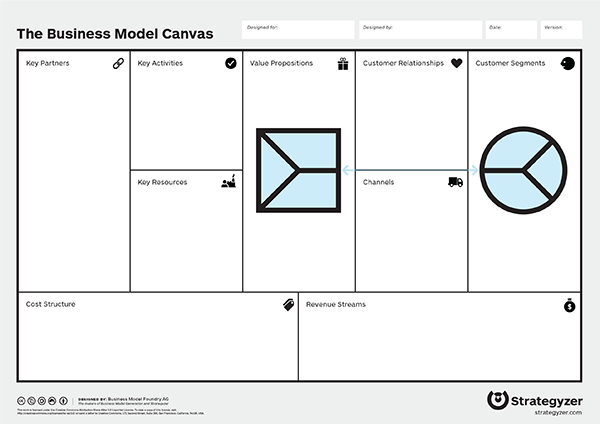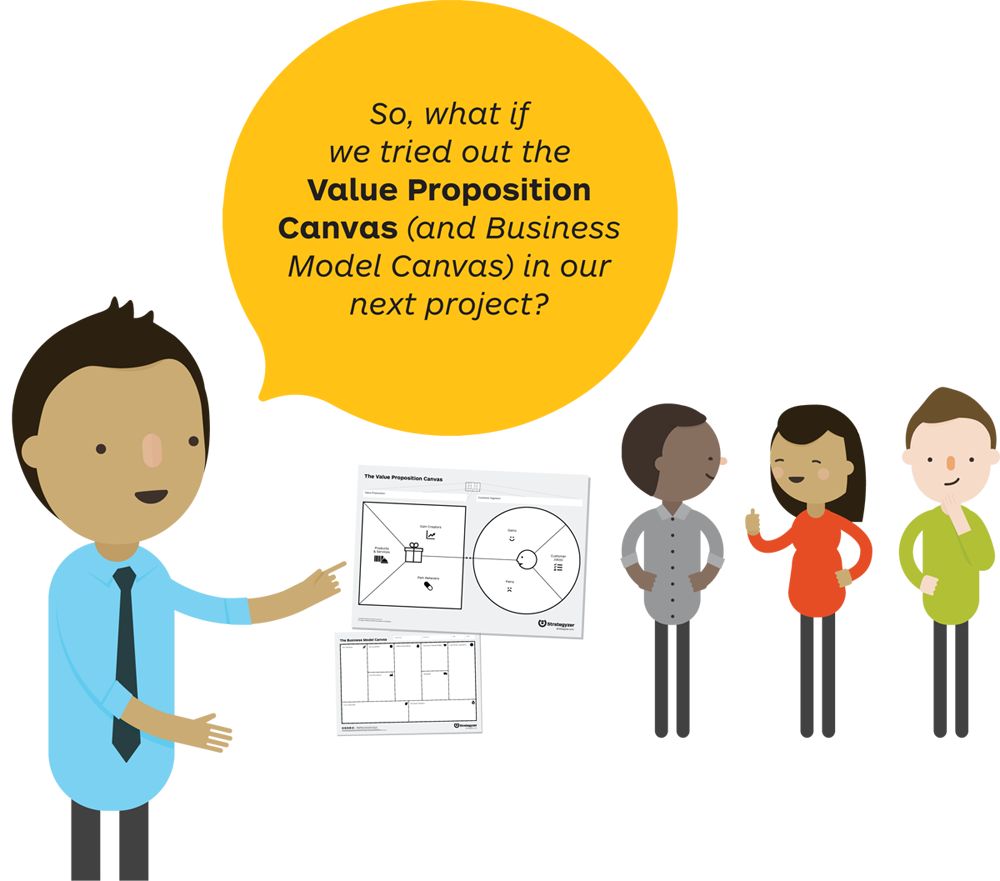

How to create products and services customers want.
Get started with . . .
strategyzer.com/vpd
Designed by
Trish Papadakos


Cover image: Pilot Interactive
Cover design: Alan Smith and Trish Papadakos
Copyright © 2014 by Alexander Osterwalder, Yves Pigneur, Alan Smith, Greg Bernarda, and Patricia Papadakos. All rights reserved.
Published by John Wiley & Sons, Inc., Hoboken, New Jersey.
Published simultaneously in Canada.
No part of this publication may be reproduced, stored in a retrieval system, or transmitted in any form or by any means, electronic, mechanical, photocopying, recording, scanning, or otherwise, except as permitted under Section 107 or 108 of the 1976 United States Copyright Act, without either the prior written permission of the Publisher, or authorization through payment of the appropriate per-copy fee to the Copyright Clearance Center, 222 Rosewood Drive, Danvers, MA 01923, (978) 750-8400, fax (978) 646-8600, or on the web at www.copyright.com. Requests to the Publisher for permission should be addressed to the Permissions Department, John Wiley & Sons, Inc., 111 River Street, Hoboken, NJ 07030, (201) 748-6011, fax (201) 748-6008, or online at www.wiley.com/go/permissions.
Limit of Liability/Disclaimer of Warranty: While the publisher and author have used their best efforts in preparing this book, they make no representations or warranties with the respect to the accuracy or completeness of the contents of this book and specifically disclaim any implied warranties of merchantability or fitness for a particular purpose. No warranty may be created or extended by sales representatives or written sales materials. The advice and strategies contained herein may not be suitable for your situation. You should consult with a professional where appropriate. Neither the publisher nor the author shall be liable for damages arising herefrom.
For general information about our other products and services, please contact our Customer Care Department within the United States at (800) 762-2974, outside the United States at (317) 572-3993 or fax (317) 572-4002.
Wiley publishes in a variety of print and electronic formats and by print-on-demand. Some material included with standard print versions of this book may not be included in e-books or in print-on-demand. If this book refers to media such as a CD or DVD that is not included in the version you purchased, you may download this material at http://booksupport.wiley.com. For more information about Wiley products, visit www.wiley.com.
ISBN 978-1-118-96806-2




 Get “From Failure to Success” poster
Get “From Failure to Success” poster

Organize information about what customers want in a simple way that make the patterns of value creation easily visible. As a result, you will more effectively design value propositions and profitable business models that directly target your customers’ most pressing and important jobs, pains, and gains.
Gain clarity.

Equip your team with a shared language to overcome “blah blah blah,” conduct more strategic conversations, run creative exercises, and get aligned. This will lead to more enjoyable meetings that are full of energy and produce actionable outcomes beyond a focus on technology, products, and features toward creating value for your customers and your business.
Get your team aligned.

Relentlessly test the most important hypotheses underlying your business ideas in order to reduce the risk of failure. This will allow you to pursue big bold ideas without having to break the bank. Your processes to shape new ideas will be fit for the task and complement your existing processes that help you run your business.
Minimize the risk of a flop.

 Get “From Failure to Success” poster
Get “From Failure to Success” poster
 Strategyzer logo and follow the link to
Strategyzer logo and follow the link to 



The heart of Value Proposition Design is about applying Tools to the messy Search for value propositions that customers want and then keeping them aligned with what customers want in Evolve.
Value Proposition Design shows you how to use the Value Proposition Canvas to Design and Test great value propositions in an iterative search for what customers want. Value proposition design is a never-ending process in which you need to Evolve your value proposition(s) constantly to keep it relevant to customers.
Manage the messy and nonlinear process of value proposition design and reduce risk by systematically applying adequate tools and processes.
The value propositions visible and tangible and thus easier to discuss and manage. It perfectly integrates with the Business Model Canvas and the Environment Map, two tools that are discussed in detail in Business Model Generation,* the sister book to this one. Together, they shape the foundation of a suite of business tools.
The Value Proposition Canvas zooms into the details of two of the building blocks of the Business Model Canvas.

* Business Model Generation, Osterwalder and Pigneur, 2010.
Embed your value proposition in a viable business model to capture value for your organization. To do so, you can use the Business Model Canvas, a tool to describe how your organization creates, delivers, and captures value. The Business Model, and Value Proposition Canvas perfectly integrate, with the latter being like a plug-in to the former that allows you to zoom into the details of how you are creating value for customers.
The refresher of the Business Model Canvas on this spread is sufficient to work through this book and create great value propositions. Go to the online resources if you are interested in more or get Business Model Generation,* the sister publication to this book.
are the groups of people and/or organizations a company or organization aims to reach and create value for with a dedicated Value Proposition.
are based on a bundle of products and services that create value for a Customer Segment.
describe how a Value Proposition is communicated and delivered to a Customer Segment through communication, distribution, and sales Channels.
outline what type of relationship is established and maintained with each Customer Segment, and they explain how customers are acquired and retained.
result from a Value Proposition successfully offered to a Customer Segment. It is how an organization captures value with a price that customers are willing to pay.
are the most important assets required to offer and deliver the previously described elements.
are the most important activities an organization needs to perform well.
shows the network of suppliers and partners that bring in external resources and activities.
describes all costs incurred to operate a business model.
is calculated by subtracting the total of all costs in the Cost Structure from the total of all Revenue Streams.
*Business Model Generation (2010), Osterwalder and Pigneur

 Download detailed Business Model Canvas Explanation and the Business Model Canvas pdf
Download detailed Business Model Canvas Explanation and the Business Model Canvas pdf
Are you creating something from scratch on your own or are you part of an existing organization? Some things will be easier and some harder depending on your strategic playground.
A start-up entrepreneur deals with different constraints than a project leader for a new venture within an existing organization. The tools presented in this book apply to both contexts. Depending on your starting point you will execute them in a different way to leverage different strengths and overcome different obstacles.
Individuals or teams setting out to create a great value proposition and business model from scratch

Teams within existing companies setting out to improve or invent value propositions and business models
 Get “Innovating in Established Organizations” poster
Get “Innovating in Established Organizations” poster

Invent and improve value propositions. The tools we will study work for managing and renewing value propositions (and business models) just as much as for creating new ones. Put the Value Proposition and Business Model to work to create a shared language of value creation in your organization. Use them to continuously invent and improve value propositions that meet customer profiles, which is an undertaking that never ends.

Invent new value propositions that people want with business models that work.

Manage, measure, challenge, improve, and renew existing value propositions and business models.

Complete our online test and assess whether you have the attitude and skills required to systematically be successful at value proposition design. Take the test before and after working through Value Proposition Design to measure your progress.
 Take your skills test online
Take your skills test online

You enjoy trying out new things. You don’t see the risk of failing as a threat but an opportunity to learn and progress. You easily navigate between the strategic and the tactical.

You systematically use the Value Proposition Canvas, Business Model Canvas, and other tools and processes in your search for great value propositions and business models.

You explore multiple alternatives before picking and refining a particular direction. You are comfortable with the nonlinear and iterative nature of value creation.

You relentlessly take a customer perspective and are even better at listening to customers then selling to them.

You systematically seek evidence that supports your ideas and tests your vision. You experiment at the earliest stages to learn what works and what doesn’t.
| I am… |
concerned that we don’t have a methodology to track our progress on the development of that new value proposition and business model. |
worried that we focus too much on products and features instead of creating value for customers. |
astonished at how poorly aligned product development, sales, and marketing are when it comes to developing new value propositions. |
surprised at how often we make stuff nobody wants, despite our good ideas and good intentions. |
really disappointed by how much we talked about value propositions and business models at our last meeting without really getting tangible results. |
blown away by how unclear that last presentation on that new value proposition and business model was. |
amazed by how many resources we wasted when that great idea in that last business plan turned out to be flop because we didn’t test it. |
concerned that our product development process doesn’t use a more customer-focused methodology. |
surprised that we invest so much in research and development (R&D), but fail to invest in developing the right value propositions and business models. |
not sure if everybody in our team has a shared understanding of what a good value proposition actually is. |

 Get a slide deck with 10 arguments to use the Value Proposition and Business Model Canvas
Get a slide deck with 10 arguments to use the Value Proposition and Business Model Canvas
Note to the Reader:
The print edition of this book is designed around large, four-color two-page spreads.
This digital version has been reformatted for smaller ebook readers and mobile devices.